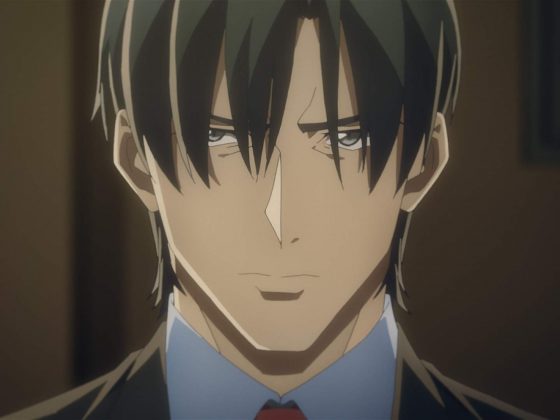
Babylon’s story follows public prosecutor Zen Seizaki. As he uncovers the political crimes behind the Shiniki District elections, Babylon’s pacing becomes chaotic, spiraling viewers into the depths of a corrupt election.
To keep viewers intrigued, Kiyotaka Suzuki (Director) and Jin Aketegawa (Sound Director) employ several techniques to misdirect the main character--and by proximity, the viewers.
Both Suzuki and Aketegawa understand the importance of pacing. By releasing key information through visuals and sound, they contribute to the perception of the story and its careful pacing.
For this article, I’ll show how pacing influences film and sound decisions in Babylon’s early episodes. By comparing episodes 1 and 2, I hope to show how pacing is tied to the show’s tone, character nuance, and revelation of its mystery.
A Brief Explanation: Pacing’s Importance
Before moving forward, we’ll discuss pacing and its relevance. In the context of writing, pacing is the perceived speed a story unfolds. Since pacing can be influenced by perception, this means that even long passages can seem fast with the right techniques.
For example, a passage with a lot of active verbs, few descriptions, and short sentences can have a quick pace. The speed through which an audience can absorb information is easy, therefore the pace by which they go through that passage can be fast.
By comparison, a passage with lengthy sentences, many descriptive details, and little action will be read at a different pace. The necessity of absorbing details will slow the pace of the reading as long as details are relevant.
One factor that can influence relevance is a beat. In films/plays, a beat is a pause, event, emotional change, or revelation/understanding that changes how a character pursues their goal. Scenes with more beats require an audience to understand what changed a character’s motivation--therefore a scene can feel fast-paced as beats switch how a character pursues their goal.
Furthermore, beats can be applied to the story as well. When critical information is revealed, it can change the direction of a story, thus a story beat. For the sake of brevity, we will only be talking about this type of story beat.
The Craftmanship of Chaos
Babylon’s first episode starts in medias res (in the middle of things), requiring viewers to focus or quickly be lost. Juggling this information while trying to remember character names, established motivations, and setting can quickly snowball.
As a mystery, the first episode aptly establishes its premise. By providing more questions than answers, it wants to invoke a viewer’s interest. Why is a pharmaceutical company linked to political elections? Why does an ominous, ineligible letter appear with the seized company assets? Why is Inaba, an anesthesiologist found dead in his apartment? Why is Shiniki, an independent city, brought up as part of the investigation?
All these questions end on a cliff-hanger, a final image. Fumio, Zen’s assistant/ an up-and-coming prosecutor, is found dead in his apartment. The hectic events of the pilot episode are magnified further by its pacing.
With barely 20 minutes to think, it’s not surprising viewers are left confused. However, this is intentional. Time is needed to understand information and without a moment to breathe (a slower pace), details will escape the viewers--just as they escape the protagonist.
Information Flow: Pacing Influences Understanding
While episode 1 sets the premise and introduces the plot, episode 2 is deliberately slower, allowing viewers to understand Zen’s character and beliefs.
From the onset, the tone is melancholy. The very person whose death ended the last episode returns in memory. "What does being a public prosecutor mean to you, Mr. Seizaki?" Surprised by the sudden question, Zen takes a moment to answer Fumio, "You want to become a public prosecutor...You're serious, right? If you are, then you should work to become the kind of public prosecutor you yourself want to be."
At his response, Fumio walks away, but quickly realizes, Zen didn’t answer his question.
"So... what was your answer, Mr. Seizaki?" Fumio probes further. "That goes without saying.” Zen raises a coffee mug to his lips. “It means upholding justice…” the scene cuts to the present. Zen lowers his coffee and finishes his line, “and protecting people." Missing from the picture is Fumio. Rain, now audible in the background, punctuates the scene with Zen’s lonely frame.
Babylon is a mixture of genres. It’s a thriller, which thrives off of quick pacing. It’s a mystery, which values a contemplative (slow) pacing. It’s psychological, which needs an understanding of motivation. The first episode has shaken our protagonist. The second episode must then have him reexamine his values--find his way through Babylon’s maze.
As if alive, the piano finds a newfound resolve. It pauses then leads us into the next scene. For a moment, the rain’s sound gives way to a strong wind. During this, Zen pays his respects at Fumio’s funeral, which is intercut with a discussion with Morinaga, head of the Public Prosecutors.
Morinaga explains that Fumio’s death is being ruled a suicide. He then asks Zen if that’s what he thinks, “That’s impossible,” Zen says with his expression covered and his back to Fumio’s funeral photo. The scene now cuts to Zen in the car with Morinaga. Zen explains, “He had no reason to.” When Zen clarifies further, he moves his face away from the camera. Just as before, the camera hides Zen’s expression, “Fumio was… murdered.” With that statement, the traffic lights go red.
The pacing moves at the speed of the car, slowly through traffic, stopping when necessary. Episode 1, by comparison, moves at a pace that disregards its characters. Chaos is the goal behind its pacing--and furthermore, the goal behind the mastermind. While episode 1 was meant to shroud intentions, episode 2 requires its character to unveil intentions.
Once the opening ends, Zen is interrogating a new character. Immediately noticeable is the smaller screen; black bars border the top and bottom, constraining the space we see. Viewers are forced to look towards the center, and what meets them is a pair of blue, translucent eyes.
We are now eye-to-eye with a witness. One who disregards the truth. One who bends and controls the narrative. She calls herself Ms. Emiko Hiramatsu, but Zen interrogates her further--is that her true name?
She interrupts his question with a unique statement. She reads his name aloud, “Seizaki (正崎) Zen (善)... Meaning ‘Just’ and ‘Good’.” When Zen reiterates his question, “Ms. Emiko” opens her mouth slowly. The screen cuts to black when she answers yes.
It is only later we learn her true name.

Final Thoughts
Public order rests upon Zen’s shoulders. In order to protect the public, he must seize the truth, live up to his namesake of “Just” and “Good.” The sooner Zen can regain his bearings, the sooner the puzzle comes together.
In this show, “Justice” is easily manipulated, shoved into directions at the whims of corrupt laws and politicians. In order to give to place viewers in Zen’s shoes, pacing throws us around--our confusion shared. In order to give viewers the right tools to solve the mystery, pacing gives us the right moments to think, to invoke a “zen-like” state. Through a careful combination of audio and visual cues, these moments of calm become a foothold towards finding the truth.

